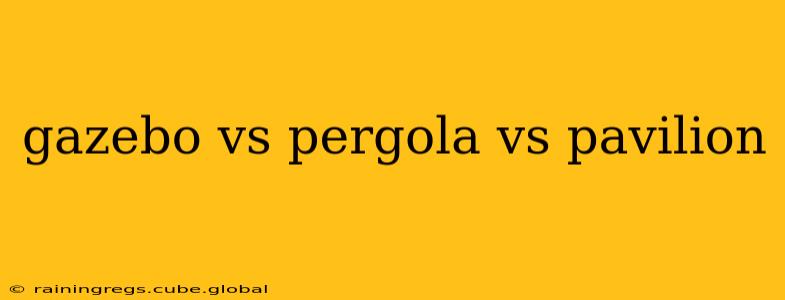Choosing between a gazebo, pergola, or pavilion can be tricky, as they all offer shaded outdoor spaces. However, key differences in their structure, function, and overall aesthetic make each a unique choice for your landscape. This guide will delve into the specifics of each, helping you determine which best suits your needs and style.
What is a Gazebo?
A gazebo is a freestanding, often octagonal or round, structure with a roof and open sides. Think of it as a small, elegant garden house. Gazebos are typically self-supporting, meaning they don't require attachment to an existing structure. They often feature intricate details, decorative roofing, and sometimes even screens or curtains for added privacy and protection from insects. Gazebos are primarily designed for relaxation and socializing, offering a sheltered spot to enjoy the outdoors.
What are Gazebos Used For?
- Relaxation and Recreation: Gazebos provide a peaceful retreat for reading, meditating, or simply enjoying the scenery.
- Social Gatherings: Their sheltered space is perfect for hosting small parties or intimate gatherings.
- Adding Architectural Interest: Gazebos can significantly enhance the aesthetic appeal of a garden or backyard.
What is a Pergola?
Unlike gazebos, pergolas are essentially open-roofed structures. They consist of a framework of posts and beams, often made of wood or metal, creating a shaded walkway or patio cover. Pergolas rarely have walls and are typically attached to an existing structure like a house or fence. Their open design allows for climbing plants to grow across the framework, providing natural shade and a lush, green aesthetic.
What are Pergolas Used For?
- Creating Shade: The main function of a pergola is to provide shade, often over a patio or walkway.
- Defining Outdoor Spaces: Pergolas can help to create distinct areas within a larger garden or yard.
- Supporting Climbing Plants: Their structure provides the perfect support for vines, roses, and other climbing plants.
What is a Pavilion?
A pavilion is a broader term that encompasses various types of outdoor structures. It generally refers to a free-standing building, larger than a gazebo, that offers shelter and shade. Pavilions can range in design from simple, open-sided structures to more elaborate buildings with walls, windows, and even electricity. Think of them as a cross between a gazebo and a small shed, offering more flexibility in size and functionality.
What are Pavilions Used For?
- Larger Gatherings: Pavilions can accommodate larger groups of people than gazebos.
- Outdoor Dining and Entertaining: Many pavilions offer ample space for dining tables and comfortable seating.
- Versatile Uses: They can serve as a workshop, storage area, or even a guest house depending on their design and construction.
Gazebo vs. Pergola vs. Pavilion: Key Differences Summarized
| Feature | Gazebo | Pergola | Pavilion |
|---|---|---|---|
| Structure | Freestanding, roofed | Attached, open-roofed | Freestanding, varied |
| Size | Typically smaller | Varies, often longer | Typically larger |
| Walls | Usually open, sometimes screened | No walls | Can have walls |
| Primary Use | Relaxation, small gatherings | Shade, plant support | Larger gatherings, versatile use |
Frequently Asked Questions (FAQ)
What is the difference between a gazebo and a pergola?
The main difference lies in the roof. Gazebos have a solid roof, providing complete protection from the elements. Pergolas have an open roof, offering shade but less protection from rain. Gazebos are also typically freestanding, while pergolas are often attached to a building.
Which is better, a gazebo or a pavilion?
The "better" choice depends entirely on your needs and preferences. Gazebos are ideal for smaller spaces and intimate gatherings. Pavilions offer more space and versatility for larger groups and a wider range of uses.
Can I build a gazebo, pergola, or pavilion myself?
Yes, all three structures can be built by DIY enthusiasts, though the complexity and required skills vary. Simple pergolas are often the easiest to construct, while elaborate gazebos and pavilions may require more advanced carpentry skills. Always carefully plan and follow instructions for safe and successful construction.
How much do gazebos, pergolas, and pavilions cost?
The cost varies greatly depending on size, materials, and complexity of design. Simple pergolas can be relatively inexpensive, while custom-built gazebos and pavilions can be significantly more costly.
By understanding the nuances of each structure, you can make an informed decision that complements your outdoor space and lifestyle. Remember to consider factors like budget, available space, and desired functionality when making your choice.
